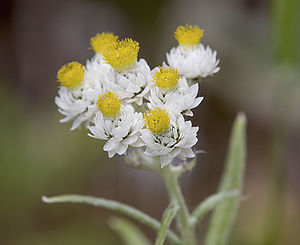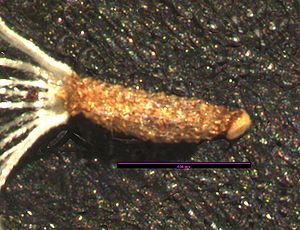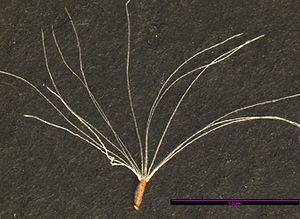Difference between revisions of "Anaphalis margaritacea"
| Line 5: | Line 5: | ||
* Codon: ANAMAR | * Codon: ANAMAR | ||
[[File:ANMA RodGilbert flw good.jpg |thumb|Photo by Rod Gilbert. Also featured on Main Page]] | [[File:ANMA RodGilbert flw good.jpg |thumb|Photo by Rod Gilbert. Also featured on Main Page]] | ||
| − | == Taxonomy == | + | === Taxonomy === |
{{Taxobox | {{Taxobox | ||
| image = | | image = | ||
| Line 73: | Line 73: | ||
'''Longitudinal Cross Section:''' elliptical [[File:ANMA-long-crosssection.png]] | '''Longitudinal Cross Section:''' elliptical [[File:ANMA-long-crosssection.png]] | ||
| − | ==Photo Gallery== | + | ===Photo Gallery=== |
<gallery> | <gallery> | ||
File:ANAMAR2.jpg|Photo: Craig Althen, 2010 | File:ANAMAR2.jpg|Photo: Craig Althen, 2010 | ||
| Line 79: | Line 79: | ||
</gallery> | </gallery> | ||
| − | == References == | + | === References === |
<references /> | <references /> | ||
Revision as of 13:06, 20 March 2021
- Scientific Name: Anaphalis margaritacea
- Family: Asteraceae
- Common Names: pearly everlasting
- Synonyms/Misapplications: Gnaphalium margaritaceum
- Codon: ANAMAR
Contents
Taxonomy
| Scientific classification | |
|---|---|
| Kingdom: | Plantae |
| Subkingdom: | Viridiplantae |
| Phylum: | Tracheophyta |
| Subphylum: | Spermatophytina |
| Class: | Magnoliopsida |
| Subclass: | Asteranae |
| Order: | Asterales |
| Family: | Asteraceae |
| Genus: | Anaphalis DC. |
| Species: | Anaphalis margaritacea (L.) Benth. |
| Synonyms | |
| |
Plant Description
Individual, erect, cottony stems grow 1-3 ft. tall and are often clumped together creating a bushy appearance. Narrow leaves are gray-green to woolly-white. Globular flowers are actually long-enduring, white, dry bracts arranged around a yellow center. Several evenly leafy woolly stems in a small patch are topped by a crowded, roundish cluster of flower heads with pearly-white bracts, sometimes with a dark spot at base of each outer bracts. The dried stalks with their pearly-white heads are attractive in floral arrangements. The pure white flower is commonly used in dried flower arrangements. Good dried flowers; food plant for Painted lady butterflies.[2]
Bloom Period
July through September.[3]
Distribution
Widely distributed throughout Washington; occurring throughout North America except for portions of Midwest and Southeast.[3]
Habitat
Dry to somewhat moist open areas, low to sub-alpine elevations.[3]
Uses
In folk medicine, it is used as a salve for burns. (Strickland)[2]
Propagation
[Propagation protocol from USDA NRCS]
Seed
Seed sample from 2010
Average Measurement: 0.6 x 0.2 x 0.2
Measurement Range: L: 0.4 - 0.75, W: 0.1 - 0.3, D: 0.1 - 0.3
Features
Shape: Seeds somewhat ribbed. Right above hilum, seed narrows considerably before flaring out again.
Color: Seed is brown. Hilum is glossy and puckered, lighter colored that rest of seed.
Additional Features: Pappus of downy white hairs significantly longer that seed itself.
Surface: Seed covered in clear globules and is slightly lustrous.
Could be confused with: Antennaria howellii
Latitudinal Cross Section: elliptical ![]()
Longitudinal Cross Section: elliptical ![]()
Photo Gallery
References
- ↑ Integrated Taxonomic Information System. Retrieved from https://www.itis.gov/servlet/SingleRpt/SingleRpt?search_topic=TSN&search_value=36529
- ↑ 2.0 2.1 Native Plants of North America.” Retrieved from https://www.wildflower.org/plants/result.php?id_plant=anma.
- ↑ 3.0 3.1 3.2 WTU Herbarium, Burke Museum, & University of Washington. Retrieved from http://biology.burke.washington.edu/herbarium/imagecollection/taxon.php?Taxon=Anaphalis%20margaritacea





